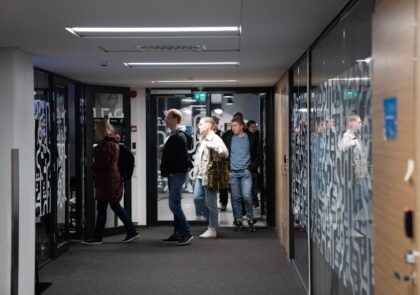
Do you buy your clothes from a supermarket? Do you check the origin of the garment? What kind of image will you get if you see the tag Made in Bangladesh? This article investigates supermarket clothes origin and supply chain sustainability. Details matter in decision-making and here are some points that you can check.
Kirjoittaja: Kati Jaakkola
We do have a demand for clothes, we purchase clothes from the supermarket at the same go as we do the grocery shopping. You need a shirt for next week’s meeting, and you fulfill the need for socks for your kid. Most probably you will check the size, fit the shirt, and feel the texture of the textile. You also consider the price that you are willing to pay for this piece of clothing. I guess you are not paying too much attention to the supply chain or the country of origin, nor to issues like the supply chain ESG. Environmental, Social, and Governance (ESG) is a framework to assess the business practices of an organization in ethical and sustainability matters (Mathis & Stedman).
Various steps are on the way before wearing a shirt
The cotton is most likely handpicked and possibly transported by a donkey, on the earliest part of the journey of the raw material. Furthermore, the cotton is processed in a factory to be yarn and then woven into a fabric roll. The fabric is colored or printed and then cut and sewn to be a particular piece of clothing. From the Finnish perspective, this is all done in faraway countries, on another continent.
Yhteishyvä (03/2023) magazine published an interesting article about sewer life in Bangladesh. The auditing team of the S-Group visited Bangladesh’s cooperating factories in April 2023. The S-Group has picked eight factories that they cooperate with, and all these factories are following the Business Social Compliance Initiative (BSCI). BSCI is improving social performance in global supply chains by improving the visibility in production (Amfori BSCI). The S-Group Product Group Manager Hanna Zimmerman states that the fashion bought from supermarkets is more sustainable than many might think. The quantity of purchased material is meaningful and makes it interesting for the public. This puts pressure on supermarkets to pay attention to the origin of the product as well as to sustainability. The Product Group Manager Zimmerman is convinced that if the piece of clothing is made in Bangladesh and the production is audited by BSCI, it is a sustainable choice. (Rasi 2023.)
The journey continues to Europe
The ready-made piece of clothing has a long way to go to reach the customer in a local supermarket in Finland. After the sewing process, the shirt is packed and transported by truck in a container to a port. The container will be loaded into a huge container vessel in the Asian port. The shirt takes a long trip in a container vessel to Europe. The container vessel will be unloaded in one of the big ports in Central Europe. Once again, the container will be loaded onto a feeder vessel, a smaller container vessel, to fit the sea route to Finland. The container with the ready-made shirt will continue the journey to Vuosaari Port in Helsinki, Finland. The shirt will be handled many times before it hits your local supermarket. The transportation from Vuosaari Port is by truck to a supermarket’s central warehouse or a hub. The container will be unloaded and then the shirts will be sorted into separate shipments all around the country. The delivery from the central warehouse is done by road transportation to the destination, your local supermarket.
How does everyone get paid?
Starting from growing the cotton in the fields of Southern America, following the processing of the cotton into a shirt in Asia, and traveling from one continent to another, the shirt has had many stresses along the way. Many pairs of hands have touched the piece of clothing and many machines have been moving the shirt-containing container from one place to another. We can only imagine if there is enough paycheck for each participant from the shirt that you will buy from the local supermarket. We do consider this question with students in lectures. The five-euro T-shirt makes you think about fairness. Is it reasonable to expect such a journey, all the handling and transporting with such a small amount of money?
Stakeholders can make a difference by demanding transparency
The global supply chains are huge networks of operators, people, machines, companies, and management. The management of supply chains makes this global movement possible and more likely even profitable. The complexity of these global supply chains makes it difficult to be transparent. What we can rely on is the agreements and initiatives that are trying to make these processes transparent.
ESG matters need to be considered in each part of these huge networks. One part is fair pay for each individual participating in these chains of supply. Each individual needs shelter for herself and for the family, enough to eat every day, fresh water, affordable energy sources, well-being, and education. All this brings a possibility to take care of the community, living habitats, and finally climate actions. All these and more are mentioned in the United Nations Sustainability Goals (United Nations).
Supermarket customers as stakeholders can make a difference by demanding a more transparent view of the items that we buy every day. We can demand more information about the products that are supplied in our everyday life. This is done simply by asking questions, being aware of the cooperation that the supermarket chain is applying, and checking the labels of the clothes we buy. The S-Group have had pressure from the public and they are taking actions towards more sustainable procurement and production on the range of products they provide for the customers.
References
Amfori BSCI. Cited 23.9.2023. Available at https://www.amfori.org/content/amfori-bsci
Mathis, S. & Stedman, C. TechTarget. Cited 23.9.2023. Available at https://www.techtarget.com/whatis/definition/environmental-social-and-governance-ESG
United Nations. Cited 25.10.2023. Available at https://sdgs.un.org/goals
Rasi, M. 2023. Ompelemalla parempi huominen. Yhteishyvä. Suomen Osuuskauppojen Keskuskunta. Cited 23.9.2023. Available at https://view.24mags.com/library/yhteishyv%C3%A4#category-210
Author
Kati Jaakkola is working as a senior lecturer at LAB University of Applied Sciences, has two decades of experience in managing Supply Chains, and is eager to investigate Sustainability in Supply Chains.
Illustration: Vuosaari Port Helsinki Finland from a birds-eye perspective 2021. (Photo: Port of Helsinki. JS Suomi/Sami Perttilä)
Published 8.11.2023
Reference to this article
Jaakkola, K. 2023. Fair pay for everyone. LAB Pro. Cited and the date of citation. Available at https://www.labopen.fi/lab-pro/fair-pay-for-everyone/






